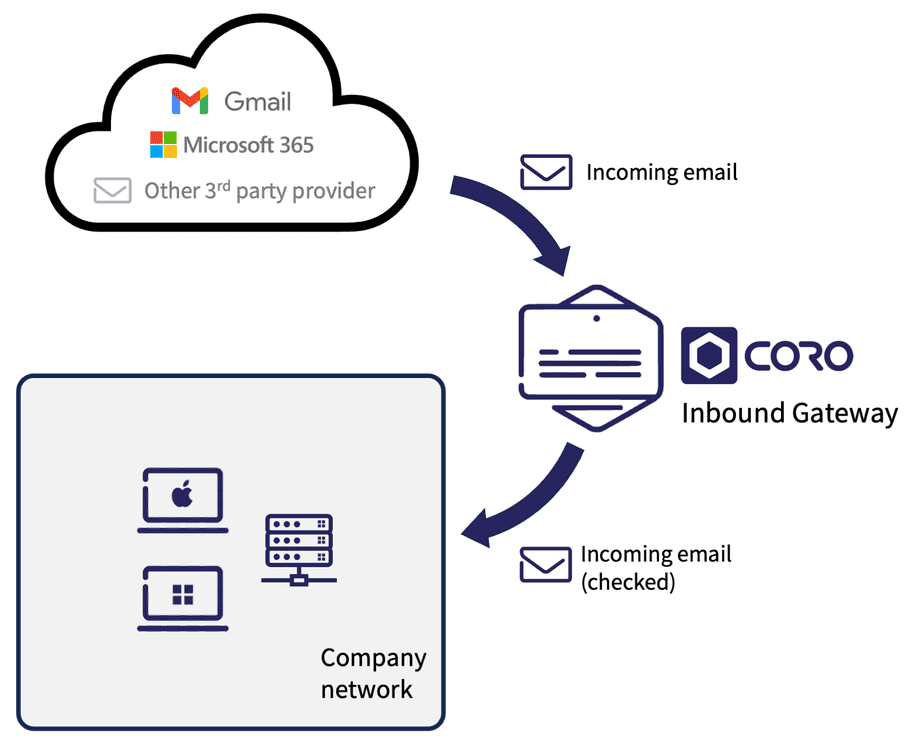Inbound Gateway
Important
This is a beta feature.
Here’s what you need to know:
- Limited support : Expect minimal technical support at this stage.
- Potential bugs : Your feedback is crucial. If you encounter any issues, report them to us at support@coro.net.
- Not for production : This feature is not yet ready for full production use or mission-critical applications.
- Constant improvements : Things might change as we refine and enhance components.
- Release updates : Stay tuned for official release news. We'll keep you posted on any changes.
This article describes Coro's Inbound Gateway email security add-on and how it can help protect your users' incoming email.
Introducing the Inbound Gateway
A subscription to Coro's Email Security module enables organizations to configure comprehensive anti-malware and anti-phishing protection for the email accounts of protected users in connected Gmail or Microsoft 365 cloud applications. Coro utilizes an API-based approach to check emails in a user's mailbox, deleting or quarantining malicious messages as appropriate. For more details, see Email Security.
Coro's Inbound Gateway add-on takes this same protection one step further by offering a full email proxy gateway that intercepts inbound emails before they enter the organization's network.

Emails passing through the Inbound Gateway are thoroughly inspected for threats, greatly reducing the number of malicious or untrusted emails that enter the organization and reach their intended recipients.
While the Email Security module is designed to protect users in connected cloud email services from Google or Microsoft, the Inbound Gateway acts on email messages from all third party providers. Messages are checked at delivery (MX/DNS level protection) and recipients can be individual accounts, groups, or shared email boxes.
In summary:
- Email Security module : Detects threats by scanning email after delivery.
- Inbound Gateway : Intercepts and processes incoming email before it is delivered.
Using the Inbound Gateway
The Inbound Gateway is an add-on to Coro's Email Security module. While you do not require real-time anti-malware and anti-phishing protection to be enabled in the Email Security module to use the Inbound Gateway add-on, combining both provides increased protection against email threats.
By incorporating the Inbound Gateway into your existing Email Security protection, you increase the probability that a threat will be detected. You additionally introduce a failover mechanism in the unlikely event that one of the protection mechanisms is blocked or prevented from full operation.
To enable the Inbound Gateway to inspect and protect your users' incoming email, you must make sure they are added to protection. If you have no cloud applications connected, this must be done manually (by adding user email addresses individually or through a CSV file-based bulk import). Alternatively, connect a cloud application to your workspace to enable Coro to identify and add all registered email users in one operation.
note
Coro's standard email security module identifies and protects only licensed user accounts in a cloud application. Where a distribution list or shared inbox within that application includes both licensed and unlicensed users, those unlicensed users cannot be protected.
The Inbound Gateway is able to protect unlicensed users. Although, to acheive this you must add all such user email addresses for protection manually.
Important
If real-time anti-phishing and anti-malware protection is disabled, your users cannot report phishing attempts through Coro's user feedback email client add-ins. This restriction remains even if you enable and configure the Inbound Gateway add-on.
Configuring the Inbound Gateway to work with your existing email provider
The Inbound Gateway offers a streamlined workflow with seamless integration into your existing email service.
The process by which you configure the Inbound Gateway to receive email from your existing provider can be summarized as follows:

You reconfigure your DNS with Coro as the highest priority MX record, and then configure your Coro workspace with details of the email domain being protected. Finally, you configure your existing email service to set Coro as the gateway for inbound email.
In normal operation, incoming email is received by the Coro Inbound Gateway and analyzed for potential threats.
Safe emails are transparently forwarded to the recipient, and malicious emails are managed by Coro according to your selected level of protection (see How Coro handles malicious email). Coro raises tickets in the console for each potentially malicious email it encounters. This enables admin users to analyze threats and take appropriate action to safely remove malicious content, or identify false positives and release the email to its recipient.
To learn more about configuring the Coro Inbound Gateway, see Configuring the gateway.